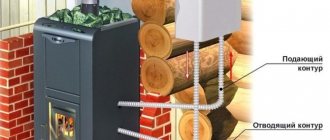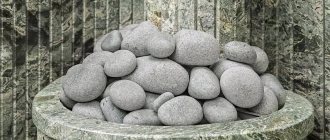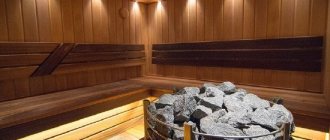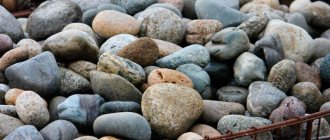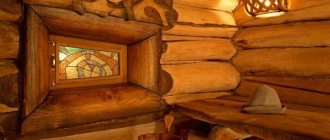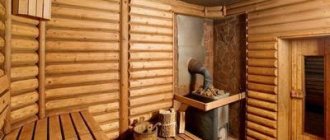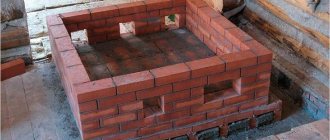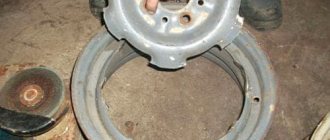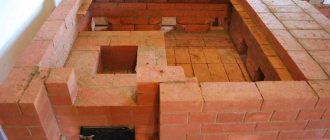5/5 — (1 vote)
Bath jasper is an interesting stone. Jasper throughout history has been considered a mysterious and enigmatic stone that helped shamans enter the astral plane and helped cure diseases. But let's go back to our time and consider this stone only in the bath area.
1. Jasper for a bath. general information.
2. Jasper. Kinds.
3. Jasper for a bath
4. Jasper for the bath. Conclusion.
Let's put all the dots right away. Bath jasper and ornamental stone are two different varieties. Now, according to tradition, let’s look at what the wiki tells us:
Jasper
,
outdated jasper
(Greek ἴασπις - variegated or speckled stone) is a cryptocrystalline rock composed mainly of quartz, chalcedony and pigmented impurities of other minerals (epidote, actinolite, chlorite, mica, pyrite, oxides and hydroxides of iron and manganese), a semi-precious ornamental stone. Some rocks traditionally classified as jaspers are rich in feldspar; these are either gray quartz-feldspathic hornfels or acidic volcanic rocks (porphyry). Among the rocks classified as jasper, there are also almost quartz-free rocks rich in garnet (up to 20% andradite).In ancient times, jaspers meant transparent colored (mostly green) chalcedony.
In the previous article about quartzites, I added Jasper to the photo for a reason. There is a certain type of Jasper (we'll talk about types later), where Jasper is in fact quartzite, and not a separate type of stone.
What happens
It’s worth starting a conversation about jasper for a bath by considering its types.
In general, jasper is a semi-precious rock of volcanic origin. It always contains hidden crystals: quartz, mica, chlorite, epidote, chalcedony, actinolite, pyrite, iron oxides, manganese, and less commonly feldspar. Depending on the predominance of one or another element, jasper changes shade and texture.
The palette of stones is very diverse. There are specimens in blue, purple, red, green, and black shades. There are always many halftones and inclusions. This is where the name “jasper” comes from, the meaning of which from Greek is bright, speckled, mottled.
The situation is similar with textures. There are representatives of breeds with spotted, striped, flattened, calico, concentric and other structures. The surface may be smoother or looser from the key component.
Most jasper-like rocks are used for ornamental and jewelry purposes. They are unsuitable for contact with steam and do not have any functions other than decorative ones.
The only jasper that is used in heaters is wax jasper.
This will be discussed further.
Main jasper deposits
Some of the largest jasper deposits are located in:
- India.
- Germany.
- France.
- USA.
But not a single country can compete with Russia. For more than two hundred and fifty years, the leadership of Ural jasper is not inferior, from the development sites that are still active to this day:
- Orsky and Urazovsky (variegated).
- Kalkansky (gray and green).
- Koshkuldinsky (interweaving of green and bright red).
- Yamsky (burgundy and fawn).
- Malouinakovsky (banded).
- Aushkulsky (oceanic).
- Berkutinsky (crimson).
On the Ural ridge there are over 200 deposits with various types of jasper
How to use in the bath
Jasper in the bath is used similarly to other stones:
in the heater
in finishing walls and floors with tiles
in decorative items
as massage devices
This breed is quite expensive, so it is rarely seen to decorate an entire steam room. For the same reason, jasper is most often placed in a kiln only as the top layer. Cheaper minerals are used as substrates.
Many professional bath attendants recommend combining wax jasper with crimson quartzite. In this option, about 2 kg of rock per heater is enough. Quartzite, on the other hand, combines perfectly in appearance, does not weigh down the steam, and even in impressive quantities does not ruin your wallet.
Decorative items made of jasper look extremely attractive, add a sense of richness to the interior and create additional steam from different points of the room.
Expert opinion
Yaremchuk Svetlana Sergeevna
The owner of a SPA salon knows everything about beauty treatments
Massage with jasper stones is perfectly perceived by hot skin. The body readily responds by relaxing, relieving spasms and improving lymph flow.
Read more about the properties of wood stove stones
In addition to the comparative table, we have prepared a description of the properties of the stones. Please note that we have placed the less expensive stones first, and the most elite options at the end.
Gabbro-diabase - a mineral for a budget bath
Figure 4. Gabbro-diabase bath stones
Visually similar to dark marble. It would be difficult to find a more ideal option for a budget bath: sufficient heat resistance, resistant to sudden temperature changes, heats up evenly and retains heat for a long time.
Promotes relaxation, maintaining the healing properties of the bath.
Raspberry quartzite - unusual shade and durability
Fig 5. Bath stones, crimson quartzite
A mineral with a beautiful purple color. Has increased thermal and mechanical resistance. And due to increased thermal conductivity, the stone quickly achieves the required heating.
Helps improve blood circulation and stabilize blood pressure.
Soapstone - takes a long time to heat up, but also takes a long time to cool down
Fig 6. Stones for bath soapstone
After a good heating of the stove, this stone will retain heat in the heater for almost a day. This mineral is often used for lining sauna stoves so that they retain heat longer.
Recommended for people with chronic diseases and weak immunity.
White quartz - stylish, beautiful and useful
Fig 7. Bath stones white quartz
A translucent white mineral that will look attractive in any oven. It produces a lot of steam and is characterized by unique healing properties.
Heated quartz releases atomic oxygen, saturating the air with ozone. Which, in turn, saturates the blood with oxygen, improving overall well-being.
Jasper is an excellent healer with life-giving steam
Fig 8. Jasper bath stones
Semi-precious ornamental stone with excellent strength and heat transfer properties.
Helps cleanse the blood, treat women's diseases, and heal wounds. Many claim that jasper reduces nervousness and successfully copes with insomnia and nightmares.
Jadeite is a stylish stone that produces thick and pleasant steam
Fig 9. Jadeite bath stones
Semi-precious stone with a rich emerald hue. It is characterized by high strength, heat capacity, and produces a large amount of steam.
It has a positive effect on the condition of the skin and lungs, strengthens the stability of the central and autonomic systems.
Jade is the strongest and most durable of all bath minerals
Fig 10. Jade bath stones
In the bath industry, jade is considered one of the best minerals due to its quality characteristics and healing properties.
Increases muscle tone, improves metabolism, and promotes general cleansing of the body. This steam will relieve fatigue, give strength and vigor.
Rules for preparation and care
Proper preparation and subsequent care allow jasper to live in a bathhouse for up to a confident 5 years. With irregular use, this period can increase by at least another half.
Bath attendants give the following recommendations in this regard:
- For the heater, select only solid stones without chips or cracks. Doubtful specimens should be removed for decoration.
- Before the first load, soak the jasper for half an hour in a saturated salt solution and dry thoroughly at room temperature. Load strictly dry material.
- The ideal laying of jasper in a heater has the shape of a pyramid: larger stones are placed at the bottom, smaller stones are placed in the middle tier, and very “trifle” stones are placed on top. Be sure to leave gaps for air circulation and uniform steam formation.
- The stones are washed exclusively with warm water. Cold or icy conditions will damage the surface and reduce service life. To increase steam, the masonry is also doused with only warm water.
- It is necessary to sort through jasper 3-4 times a year. Damaged copies must be replaced.
With this algorithm, wax jasper will quickly heat up and give off heat for a long time without significant changes in the structure.
Important Features
Let's start by highlighting what is most significant for a bathhouse. We want:
- so that the stone serves for a long time without or with minor replacement;
- so that for a long time after the stove is turned off, the heat that is essential for heating emanates from it;
- the bath heats up faster during operation of the stove ;
- so that health does not suffer from stones, but, on the contrary, improves.
- so that the stones are not too expensive (ideally, they are free))).
Different stones for a bath: which ones are better?
These are the requirements. Translating into the language of physics, we need heat-resistant , heat-intensive stones, with good heat transfer . Plus, of course, they are cheap and environmentally friendly . It would be optimal to choose those with all indicators above average. (By the way, ordinary water has the highest heat capacity; it is twice as high as that of brick for the same volume.)
Bath stones: which ones are better in terms of durability
There are two approaches: those rocks that last longer in the bath are those that are of igneous, deep origin and more or less alkaline composition (that is, the amount of silica is no more than 50%). But this is a good definition for geologists, and ordinary people are better able to navigate among the numbers. We will provide the corresponding sign, but we must warn:
IMPORTANT! The service life of a stone depends on so many factors that it is impossible to predict . The deposit, composition, impurities, type of stove, frequency of using the bathhouse, even the size and shape of the stones matter.
First of all, of course, the mineral composition of the rock and the heating temperature in the furnace . People far from geology believe that stones have the same composition if they are called by the same name. In fact, the mineral composition is variable , because the conditions of formation differ in some way. And there is much more, for example, the replacement affecting part of the production from the same field. Therefore, you need to look at specific samples.
However, here is the promised table, which allows you to very roughly estimate the heat resistance of the stone and the time it will live in the oven :
LONGEVITY TABLE
| Name | Term |
| Nephritis | 10 years |
| Jade | 4 years |
| Jasper | 2 years |
| Chromite | 5 years |
| Quartz | 3 years |
| Soapstone chlorite | 3.5 years |
| Dunit | 6 years |
| Quartzite | 4.5 years |
| Porphyrite | 5 years |
| Gabbro-diabase | 2 years |
| Cast iron | 6 years |
| Porcelain | 10 years |
As you can see, in terms of longevity, there are two candidates for the best stones for a sauna stove - jade and ceramic balls . We would also add here indestructible balls made of food-grade stainless steel . This trinity will really live for a long time in a sauna stove. But each of these materials will cost a pretty penny. (By the way, ceramics also vary in composition.)
Which stones are best for a steam bath in terms of heat capacity?
If you are not in a hurry when you are going to take a steam bath, then spare no time and firewood for the most heat-intensive stones. Here is a small table that lists not all, but many of the bath stones:
TABLE OF DENSITY, THERMAL CONDUCTIVITY AND HEAT CAPACITY
| Breed | Density g/cm³ | Thermal conductivity coefficient W/(m*K) | Specific heat capacity kJ/(kg*K) |
| Basalt | 2,6-3,25 | 0,4-3,5 | 0,5-2,1 |
| White quartz | 2,6—2,65 | — | 0,75 |
| Gabbro-diabase | 2,79-3,3 | 1,7-3,3 | 0,8-0,9 |
| Granite | 2,34-2,76 | 1,1-3,9 | 0,2-1,5 |
| Dolerite | 2,79 — 3,3 | see basalt, gabbro-diabase | see basalt, gabbro-diabase |
| Dunit | 3,28 | 1,1-1,9 | 0,6-0,8 |
| Jade | 3,25-3,35 | 2,3-3,6 | 0,88 |
| Raspberry quartzite | 2,68 | 2,6-7,6 | 0,7-1,3 |
| Jade (amphibolite) | 2,95-3,4 | 1,6-2,9 | 1,0-1,2 |
| Peridotite | 3,2-4,4 | 3,8-4,9 | 0,9-1,1 |
| Porphyrite | 2,67 | 0,7-3,5 | 1,6-1,7 |
| Rodingitis | 2,99 | — | — |
| Soapstone chlorite | 2,7-2,98 | 3,3 | 0,98 |
| Chromite | 4,5-5,0 | — | — |
| Jasper | 2,6 | — | — |
Again, the table clearly shows that the best stone for a bath in a steam room in terms of heat capacity is porphyrite. basalt into account due to the wide spread of values, but its relatives - dolerite and gabbro-diabase, although they do not have the same high heat capacity, are still more than competitive - they benefit due to their good heat capacity and low price .
You may also have noticed that the values are mostly around one - a little more, a little less, but there is no big scatter.
By the way, the same clay can, in certain conditions, accumulate heat in greater quantities than any bath rock - clay has values of up to 3.6 in the wet state (due to heat-intensive water). This means that the choice is always made simultaneously according to several criteria. Let's continue to consider them.
Stones for the stove in the bathhouse: which ones are better for health safety
This is not an idle question. First, let’s find out why bath stones can be dangerous in general. Firstly, radiation . Secondly, sulfides and other impurities , which burn out at high temperatures to form compounds harmful to humans. Thirdly, mechanical destruction, the result of which is fine dust , harmful to breathing.
Radiation
If a rock is formed at great depths in the mantle, then it will, in principle, not contain radioactive elements that are concentrated in the earth's crust. jadeite , dunite , and peridotite without any fear . All other breeds were formed higher in one way or another. But most of them do not pose any radiation hazard. The exception is granite, which may well have an increased background radiation. But, since it does not meet other characteristics, it can be forgotten.
Sulfides
Yes, this is an unpleasant “additive” to stone, which is often found in nature. There are many complaints about Karelian stones.
Sulfide decomposes at high temperatures, forming sulfur oxides, which form acids with water. Inhaling air containing sulfuric acid vapor is extremely undesirable for people.
Sulfides are easily identified visually - as gray and dark gray veins and spots with a metallic sheen or as golden crystals on the surface of the stone.
The photo gives an idea of what the sulfide may look like on the surface. But they are all dark gray with metallic. shiny or yellow, like pyrite. Photo source: Rosettes of Molybdenite, by subarcticmike's, licensed under CC BY
IMPORTANT! Follow the rule that the amount of sulfides on the surface of the stone should not be more than 5% of the total surface area. Of course, you will have to determine by eye, but still. If there are less than 5% of them, then they will simply burn out in 1-2 fires without a trace. Although it will be unpleasant, it will not last long.
Sulfides are the scourge of many stones ; there is no point in listing them, just be more careful when choosing.
Other impurities
Among other impurities we would include creosote and other substances of technogenic origin. The best from the point of view of their absence will be stones that were not paving stones or were not picked up near the railway or industrial facilities .
Dust
All stones are destroyed sooner or later, turning into sand and dust. Therefore, the heater needs to be cleaned regularly. As for soapstone, do not try to wash it clean - it tends to secrete talc and scaly chlorite, it will do this all the time it lies in the heater. Therefore, if you have a choice, then make it in favor of soapstone .
Or just put other stones that don't generate dust. It is very good for finishing. So, the best ones in terms of safety are certified stones without impurities.
Best stones by cost
Everything is simple here: better is cheaper. And gabbro-diabase remains the cheapest of the purchased stones.
We can quite reasonably recommend this particular stone, because it has suitable heat resistance and heat capacity. It is suitable for a heater due to two main characteristics. Whether it will collapse in 2 years, as the leaflet compiled by the sellers promises, or whether it will last 6-10 years depends on the case and type of stove, but this applies to all stones. Some people pick up pebbles in the forest and they last for 12 years; for others, jade does not last for a year. There are fakes and low-quality samples, but if the stone is cheap, then it is easy to replace.
Video on the topic
IMPORTANT! Complaints about the odor emitted by gabbro-diabase are complaints about sulfides . They are not always attached to the stone. Inspect samples before purchasing.
Well, you get the general idea, let's summarize what has been said.
Tips for choosing
In addition to proper preparation and care, the quality of the jasper affects the duration of operation. The criteria for selecting stones for a bath are very strict.
Even if a closed package is purchased, the breed should be sorted taking into account certain criteria:
- The optimal size of jasper for a heater is 15 cm in diameter. If there are several layers, this size is taken as the maximum value.
- It is better to give preference to specimens with a uniform color, without depressions or cracks on the surface.
- It is better to purchase from a trusted supplier. It is better to first study reviews from unfamiliar companies and individuals and ask for a certificate of authenticity of the breed.
- To compose compositions with several rocks, stones of similar parameters are selected, or a distinction is made between layers.
- It is better to use smaller stones for electric stoves, and larger stones when heating with wood.
It is also worth noting one nuance. Traditionally, crushed stones are chosen for stoves. It is believed that this shape gives off more heat due to its numerous faces, and the air circulates between them better. In the case of jasper, rounded and chipped specimens can be safely alternated.
Round units will still heat evenly and retain heat just as well. The main difference will be the cost. The price tag for polished jasper is even higher than usual. For this reason, round stones are often left for massage and decoration.
Answers to frequently asked questions
Why soak stones in salt before putting them in the oven?
Energy practitioners will say that this procedure removes negativity from stones. Regular bathhouse attendants will note the benefits of salt for strengthening the structure and increasing resistance to heat.
Red jasper has colored dots and spots. How will this affect when used in a bath?
Dots and spots indicate an uneven texture. Such stones will give off heat well, but may last less than pure red ones.
What does the marking “rounded” mean on the packaging of jasper for baths and saunas?
This means rounded outlines of stones without sharp corners or edges. They are usually smoothed out by water, either naturally or technically.
Is vintage ruby jasper for a bath different from wax jasper?
No. These are the names of wax jasper for separation by impurities in color and structure. Branded - as homogeneous as possible. Ruby has a small percentage of white inclusions. There is also agate - there are clearly visible spots and stripes.
Jasper for a bath is a wonderful gift for connoisseurs and experimenters. Light steam is perceived favorably by most people, so the session brings a lot of pleasure. Jasper can be used in a steam room, both solo and in company with other stones, which opens up great scope for bath creativity.

